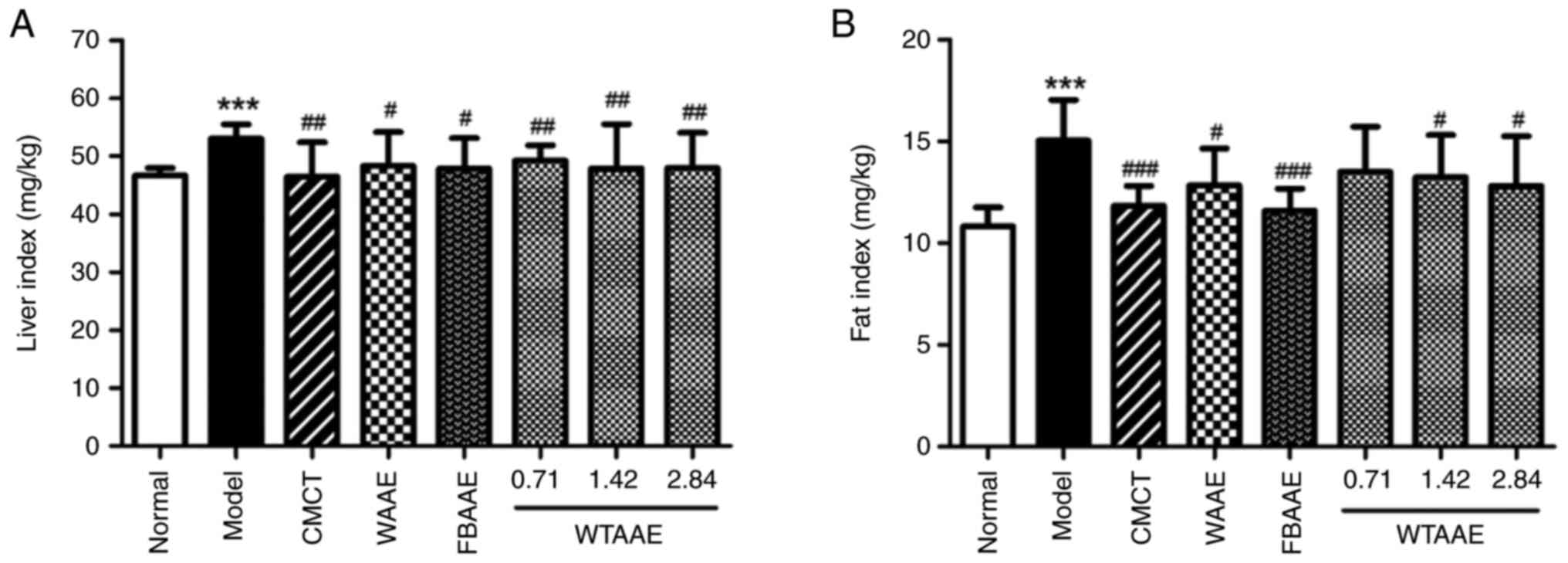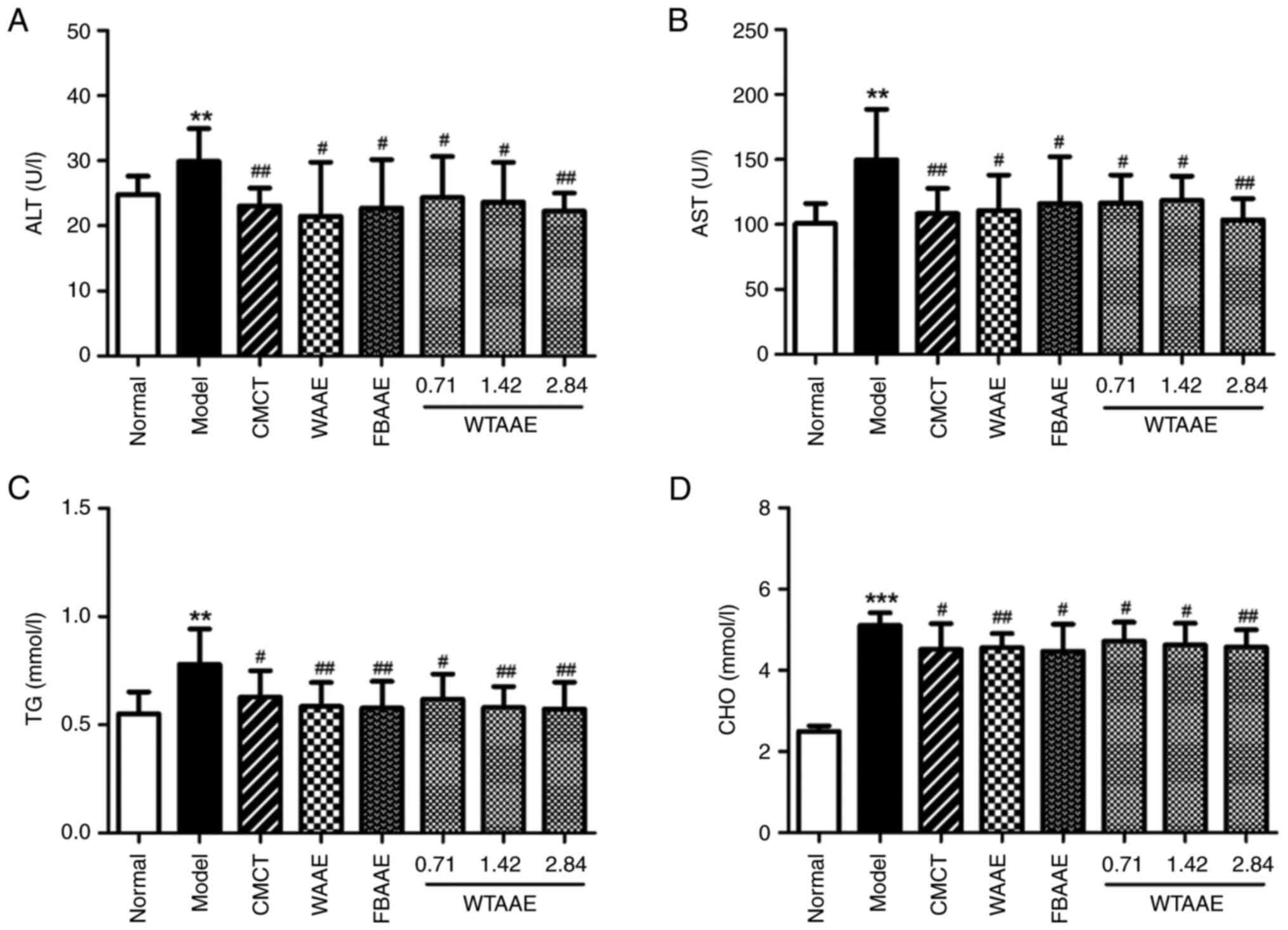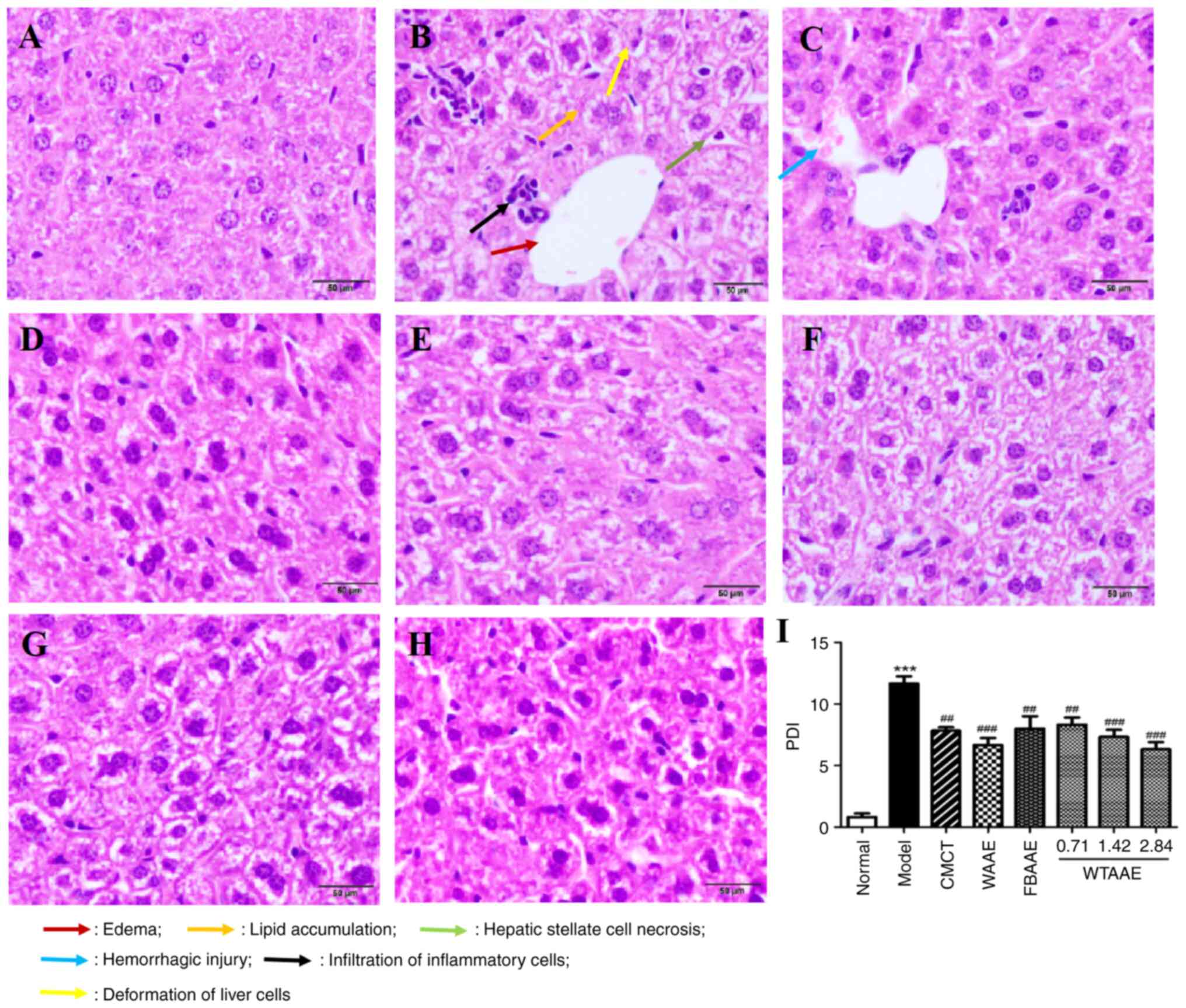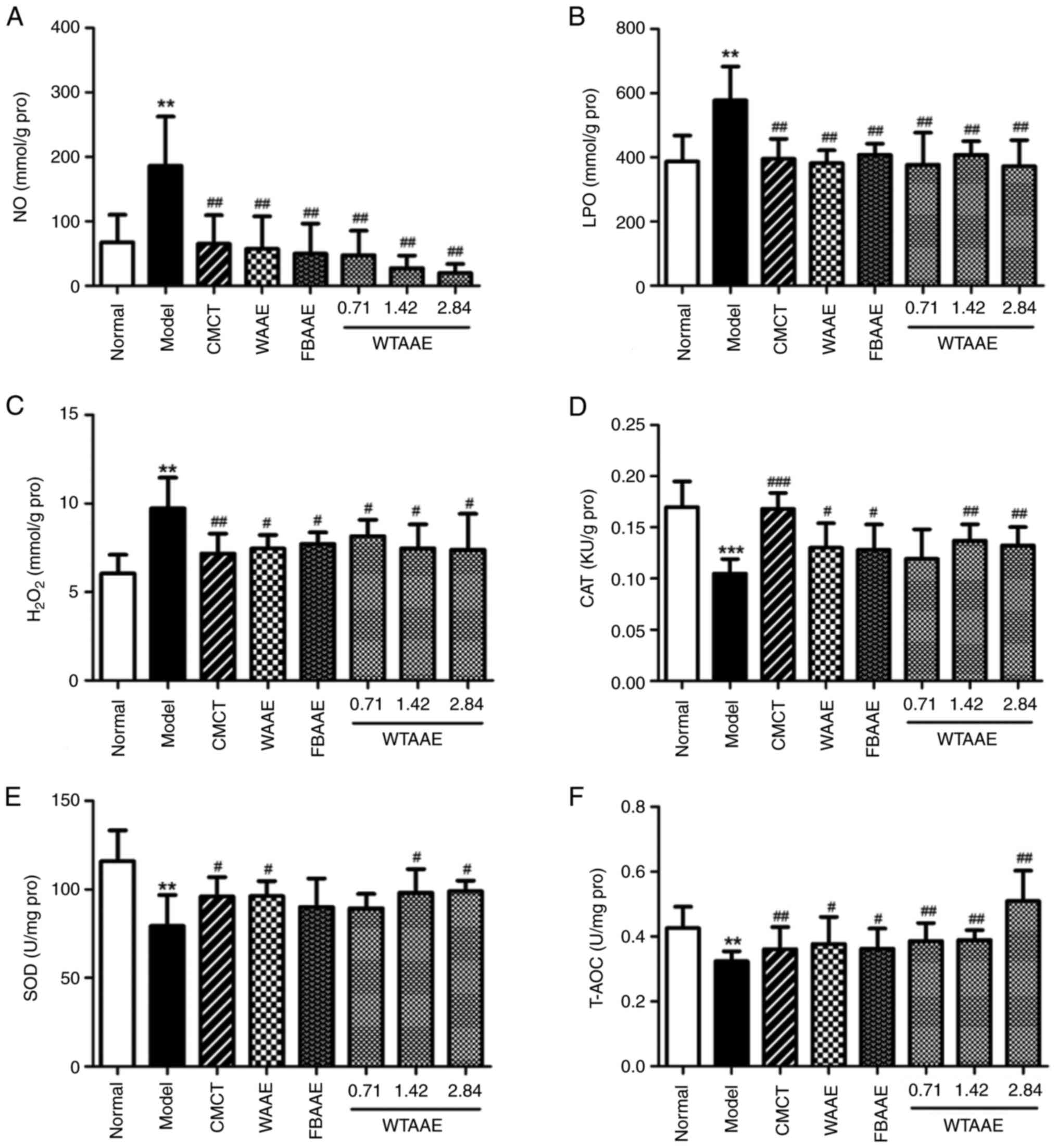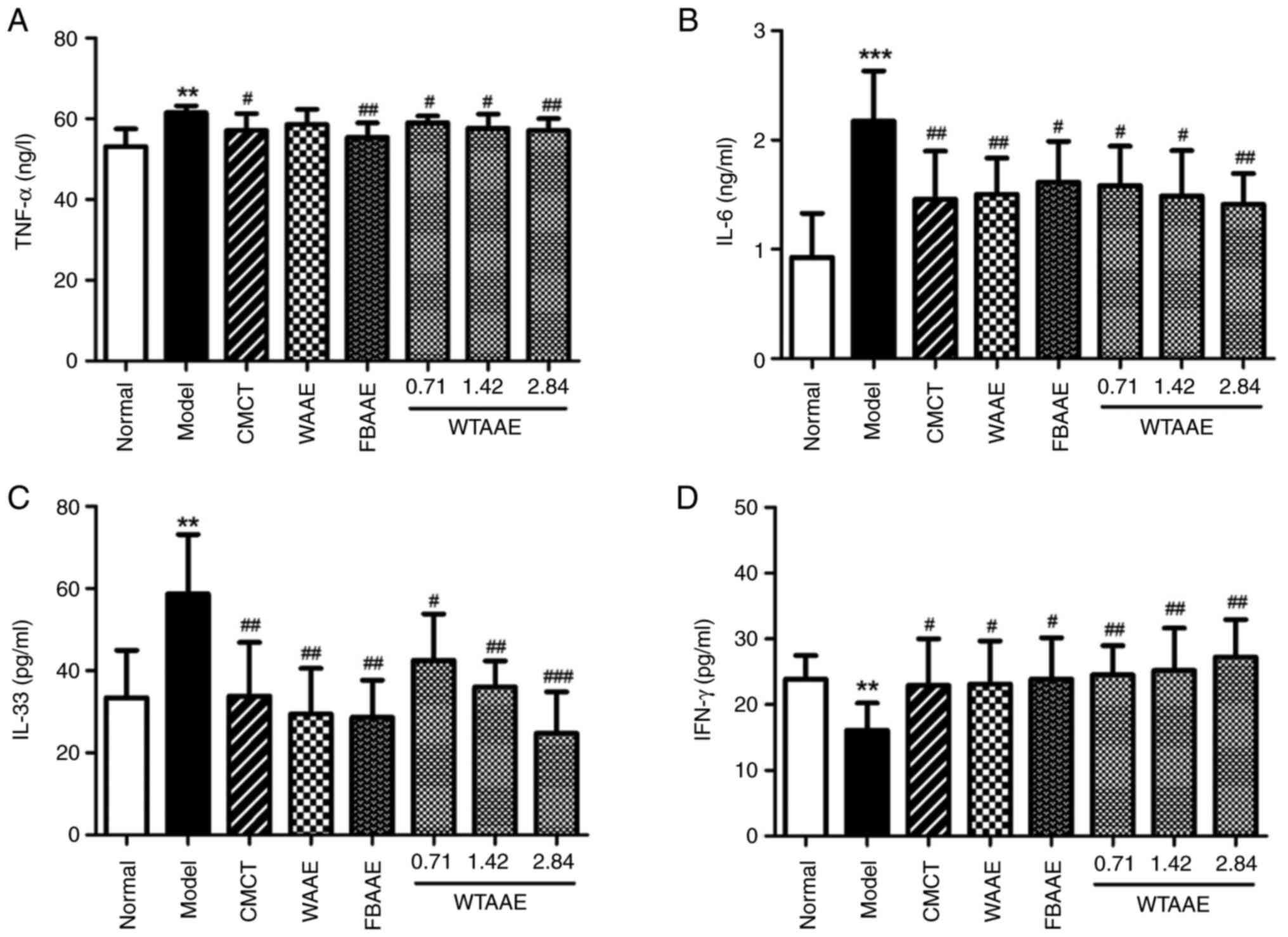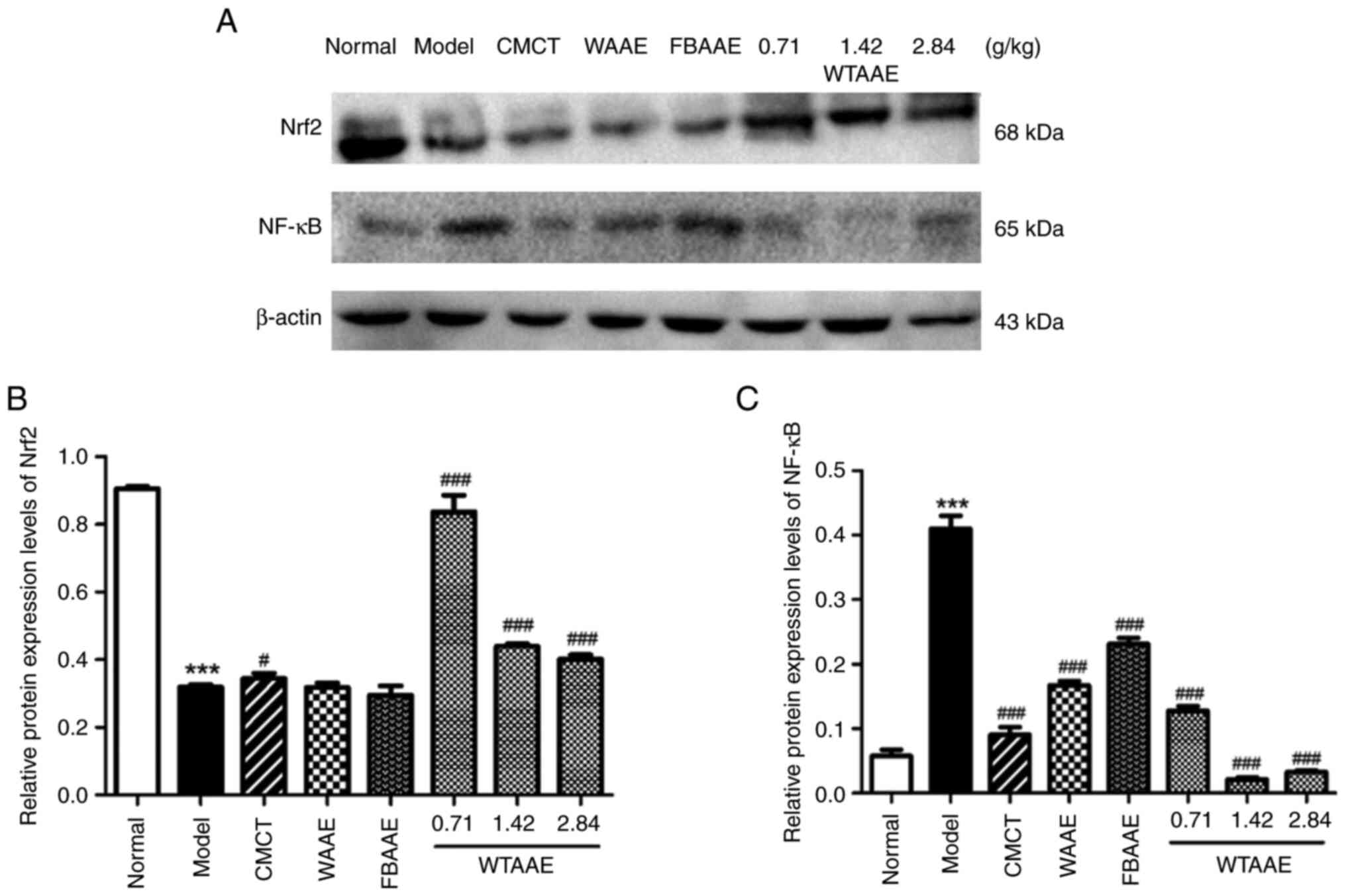Agarwood extract mitigates alcoholic fatty liver in C57 mice via anti‑oxidation and anti‑inflammation
- Authors:
- Published online on: September 21, 2023 https://doi.org/10.3892/mmr.2023.13097
- Article Number: 210
-
Copyright: © Wang et al. This is an open access article distributed under the terms of Creative Commons Attribution License.
Abstract
Introduction
Excessive ethanol consumption can lead to alcoholic fatty liver disease (AFLD), with severe cases of this disease causing hepatitis, cirrhosis and liver cancer (1). Hepatic steatosis and lipid accumulation are the earliest characteristic of AFLD and are considered a factor responsible for the progression of alcoholic liver disease (ALD) (1). A previous study reported that excessive alcohol consumption could promote liver lipid accumulation (2). Reducing fat accumulation may be sufficient to prevent the steatosis of ALD (3). Hepatic steatosis, the accumulation of lipid triglycerides (TGs) and cholesterol (CHO) in the cytoplasm of hepatocytes, is a reversible pathological condition and an early stage in the progression of ALD (2). The accumulation of excess lipids in the cytoplasmic space of hepatocytes occupies this space, which leads to the nucleus being squeezed off center, affecting the metabolism of other nutrients, hormones and vitamins, and makes these cells more vulnerable to external stimulants, such as oxidative stress, cytokine and endotoxins (4,5). Therefore, reducing hepatic steatosis may inhibit the occurrence and development of ALD. The pathogenesis of hepatic steatosis is complex and diverse, with alcohol-induced lipogenesis being an important pathogenic factor of hepatic steatosis, which promotes the synthesis of fatty acids and TG in hepatocytes (6,7).
Consuming ethanol induces oxidative damage and inflammation in liver tissue, which leads to oxidative stress and blocks lipid metabolism, contributing to ALD (8). A previous study reported that an increase in liver fat is an important pathogenic mechanism in the occurrence and development of hepatic steatosis (9). Nuclear erythroid 2-related factor 2 (Nrf2), a key transcription factor, is induced and activated by oxidative stress, which regulates the adaptive response to the oxidative stress of AFL injury and liver dysfunction (10). In addition, inflammation serves an important role in AFL injury (11). Long-term alcohol consumption damages the intestinal barrier, increases mucosa permeability and allows bacterial endotoxin to enter the circulatory system (11). Excessive endotoxin release following long-term alcohol consumption induces the inflammatory response and the progression of AFL. NF-κB is activated and transported to the nucleus, which promotes pro-inflammatory cytokine secretion (12). Therefore, inhibiting liver inflammation and restoring liver function could contribute to protection against ALF.
Agarwood is a rare and expensive fragrant wood containing resin that can be used as a spice (13). Agarwood, a traditional Chinese medicine ingredient, has been used for the treatment of various diseases, such as gastric ulcers, enteritis, myocardial ischemia, vomiting and asthma (14). Natural products of agarwood have anti-inflammatory (15–17), analgesic (18), antioxidant (19) and other biological activities, such as in sedation and improving immunity. These effects support the use of agarwood for treating certain diseases, such as hepatic disease, ulcers, angina, trauma and coughs (13,14). Our previous studies reported that agarwood extract protects against drug-induced liver injury (20,21). Our previous study also reported that agarwood has two main constituents of sesquiterpenes and chromone and the components of agarwood extract comprise sesquiterpenes (10.615%), chromone (31.678%), aromatics (31.831%) and other known compounds (25.760%) (20). Therefore, agarwood may have a protective effect against AFL by improving liver function, pathological characteristics, anti-oxidation and anti-inflammation. However, to our knowledge, it has not been previously reported that AAE has a protective effect on AFL.
The present study aimed to investigate the potential protective effect of AAE on the liver and explore its potential mechanisms of action. In addition, the protective effects of different types of AAEs on AFL were compared. The present study provided a scientific basis for the study and development of agarwood for the clinical prevention and treatment of liver disease.
Materials and methods
Reagents
Biochemical kits for the detection of AST (cat. no. C010-2-1), ALT (cat. no. C009-2-1), CHO (cat. no. A111-1-1), TG (cat. no. A110-1-1), nitric oxide (NO; cat. no. A013-2-1), H2O2 (cat. no. A064-1-1), lipid peroxide (LPO; cat. no. A106-1-3), total peroxide content (T-AOC; cat. no. A015-2-1), catalase (CAT; cat. no. A007-2-1), superoxide dismutase (SOD; cat. no. A001-3-2) and BCA (cat. no. A045-4-2) were purchased from the Nanjing Jiancheng Bioengineering Research Institute Co., Ltd. ELISA kits for the detection of TNF-α (cat. no. 8066441), IFN-γ (cat. no. 8066449), IL-6 (cat. no. 8066455) and IL-33 (cat. no. 8063899) were purchased from Bossbio Biotech. RIPA buffer (cat. no. P0013B) was bought from Beyotime Institute of Biotechnology. Nrf2 (cat. no. sc-365949), NF-κB (cat. no. sc-8008) and β-actin (cat. no. sc-8008) antibodies were purchased from Santa Cruz Biotechnology, Inc. The chemiluminescence kit (cat. no. P0018S) was purchased from Beyotime Institute of Biotechnology. Anhydrous ethanol and other chemicals purchased were of analytical grade.
Preparation of the agarwood extract
The whole-tree agarwood-inducing technique (patent no. ZL201010104119.5) was used to obtain artificially produced agarwood by the infusion agarwood-inducing technique (specimen no. JC2016112), wounding wild agarwood by causing damage via cuts to the trunk similar to wild agarwood formation (13,22) (specimen no. JC2016099) and burning agarwood via chisel-drilling using traditional or primitive fire drilling agarwood (13,22) (specimen no. JC2016076), which were purchased from the Guangdong Huzhou Guolin Agarwood Planting Cooperative. The aforementioned company was the experimental base of the agarwood-inducing production technology utilized in the present study. Agarwood was identified by Professor Jian-he Wei and stored in an air-conditioned sample room at 16°C from purchase. Agarwood alcohol extracts (AAEs) whole-tree agarwood-inducing technique alcohol extract (WTAAE), wild agarwood induced by ace wounds alcohol extract (WAAE) and burning-chisel-drilling agarwood alcohol extract (FBAAE) were extracted and prepared according to extraction methods reported in previous studies (20,22,23). Agarwood (1,000 g) was naturally dried at 30°C for a week, smashed and soaked in 95% ethanol (5 l) for 2 h. The resulting agarwood ethanol extract was extracted using reflux extraction for 1 h and filtered using 2-µm filter paper. The reflux extraction was repeated twice. The resulting ethanol solutions were combined, concentrated and dried in vacuo to obtain dark-brown WTAAE (140 g; 14%), WAAE (105 g; 10.5%) and FBAAE (140 g; 14%) which were stored in a freezer at −20°C.
Animals and experimental procedure
Healthy, adult male C57 mice (n=80; weight, 20±2 g) were purchased from the Vital River Laboratory Animal Technology Co., Ltd. (SCXK (Jing) 2017-022, Beijing, China). Animals were housed in a specific-pathogen-free laboratory animal room using a 12-h light/12-h dark cycle, with ad libitum access to food and water, and were housed for 3 days prior to experiments.
The 80 mice were randomly divided into eight groups: i) Normal; ii) model; iii) compound methionine choline tablets (CMCT); iv) WAAE; v) FBAAE; vi) 0.71 g/kg WTAAE; vii) 1.42 g/kg WTAAE; and viii) 2.84 g/kg WTAAE groups. The CMCT group was used as a positive control group. CMCT is a compound preparation of methionine choline used for the treatment of fatty liver and acute or chronic hepatitis. The dosage of WAAE (20,21), FBAAE (20,21) and WTAAEs (20,21) were determined according to the previously published conversion of human daily dosage of these compounds. The normal and model groups were orally gavaged with 20 ml/kg of distilled water. The CMCT group was orally garaged with 200 mg/kg CMCT daily. The WAAE and FBAAE groups were orally gavaged with 2.84 g/kg of the respective compounds daily. The WTAAE groups were orally gavaged with 0.71, 1.42 or 2.84 g/kg (equivalent to the mass of raw material for agarwood) (20,21) of treatment daily, respectively. All groups were fed a high-fat diet, except for the normal group, which was fed a normal maintenance diet. The composition of high fat feed included: 20% Sucrose, 15% lard, 1.2% cholesterol, 0.2% sodium cholate and the remaining food was base feed. All groups, except for the normal group, were orally gavaged with 30% ethanol, 20 ml/kg daily for 3 weeks (24). The corresponding test drugs were orally administered at 20 ml/kg daily from days 8–21. On the 21st day, the mice were fasted without water for 12 h, then blood and liver tissues were collected for the assessment of pharmacodynamic indexes. Animal care and experimental protocols were approved by the Animal Care and Use Committee at the Institute of Medicinal Plant Development, Chinese Academy of Medical Sciences (ethical approval no. SLXD-20180809012).
Determination of liver and adipose indexes
Mice were weighed 1 h after the final drug dose was administered. Mice were briefly anesthetized with cotton balls impregnated with ether. Mice were considered anesthetized when the animals lay on their back, their heart rate and breathing were even, muscles were relaxed, limbs were not moving, whiskers were not moving and their pedal reflex disappeared. Then, 0.5-1 ml of blood was collected from the retro-orbital sinus and centrifuged at 1,006.2 × g at 4°C for 15 min for serum analysis. Animals were sacrificed by cervical dislocation immediately following blood sample collection. The liver and adipose tissues were collected and weighed. The liver index and fat indexes were calculated as follows: Liver index (mg/g)=liver weight (mg)/animal weight (g); and fat index (mg/g)=fat weight (mg)/animal weight (g).
Histopathological evaluation
Histopathological changes in the liver of mice were analyzed using hematoxylin and eosin (H&E) staining (25). The liver tissues were fixed in 4% paraformaldehyde solution for 24 h at room temperature, embedded in paraffin, cut into 4-µm sections, and then stained with H&E for 25 min at room temperature. The specimens were imaged using a fluorescence microscope at ×400 magnification (Olympus Corporation). Histological damage was calculated using the following score system (PDI score): Score 0, absent (no destruction); score 0.5, few (0–20% destruction); score 1, mild (20–50% destruction); score 2, moderate (50–80% destruction); score 3, severe (80–100% destruction) (21,25).
Assessment of oxidative stress in tissues
The liver tissues were fully homogenized mechanically with saline (1:9 w/v) and were centrifuged at 1,006.2 × g at 4°C for 15 min, the supernatant was collected and used for measuring oxidative stress. The levels of NO, H2O2, LPO, CAT, SOD and T-AOC were measured using the respective biochemical kits according to the manufacturer's instructions.
Assessment of TNF-α, IL-6, IL-33 and IFN-γ levels in serum
Serum samples were collected to assess the levels of inflammatory cytokines. The levels of TNF-α, IL-6, IL-33 and IFN-γ were measured in serum using ELISA kits according to the manufacturer's instructions.
Western blotting analysis of the protein expression levels in liver tissue
Total liver proteins were extracted from liver tissues using RIPA buffer. The protein concentration was measured using a BCA protein assay. The protein was loaded onto a 10% SDS-polyacrylamide gel (20 µg/lane), transferred onto a PVDF membrane and blocked with 5% skimmed milk at room temperature for 2 h. Membranes were incubated with primary antibodies for Nrf2 (1:500), NF-κB (1:1,000) and β-actin (1:2,000) at 4°C overnight. The membrane was then incubated with secondary antibodies (1:2,000; goat anti-rabbit secondary antibody; cat. no. A0208) at room temperature for 2 h. The membranes were washed three times using TBST (0.05% Tween) and visualized using an enhanced chemiluminescence kit. The membranes were imaged using a pro-gel imaging system and protein expression levels were semi-quantified using ImageJ Software V1.8 (National Institutes of Health).
Statistical analysis
Data were expressed as the mean ± standard deviation and were analyzed using SPSS (version 17.0; SPSS, Inc.). Differences between each group were analyzed by one-way analysis of variance followed by Tukey's post hoc test. P<0.05 was considered to indicate a statistically significant difference.
Results
Effect of AAEs on liver and fat indexes
Liver and fat indexes were determined and were both significantly elevated in the model group compared with the normal group (Fig. 1). High liver and fat indexes are characterized by fat accumulation and liver edema, therefore, the high fat diet and alcohol consumption may lead to the accumulation of fat and the formation of fatty liver, which suggested that the model of AFL was successfully constructed in the present study. Pretreatment of mice with different AAEs significantly reduced the liver and adipose indexes compared with the model group for all AAEs, apart from pretreatment with 0.71 g/kg WTAAE which did not significantly impact the fat index. WTAAE pretreatment demonstrated a dose-dependent effect at reduced the liver and adipose indexes, which suggested that AAEs had a significant effect on relieving hepatic steatosis.
Effect of AAEs on AST, ALT, TG and CHO levels
The levels of liver metabolic enzymes and lipids, such as AST, ALT, TG and CHO, are key markers used to evaluate liver function (2,6,7). The levels of AST, ALT, TG and CHO were significantly increased in mice in the model group compared with the normal group, which suggested the liver function was significantly impaired (Fig. 2). Pretreatment of mice with AAEs significantly reduced the levels of the aforementioned enzymes and lipids compared with the model group. In addition, WTAAE dose-dependently reduced the liver and adipose indexes, which suggested that AAE treatment demonstrated a marked effect on restoring the liver function in AFL mice.
Effect of AAEs on histopathological lesions
The ethanol and high fat diet induced marked histopathological injuries, including lipid accumulation, edema, deformation, hemorrhagic injury, hepatic stellate cell necrosis and inflammatory cell infiltration (Fig. 3). AAEs markedly reduced this damage in liver tissues and protected against liver histopathological lesions. Mice treated with DBGTP, WAAE and FBAAE presented with less swelling and lower numbers of inflammatory cells. WTAAE pretreatment demonstrated dose-dependent protection against ALF. The pathological damage index (PDI) could show the results more directly (Fig. 3I). WTAAE and WAAE pretreatment had a similar effect at the 2.84 g/kg dose, which was more effective than FBAAE. These data suggested that AAEs demonstrated a significant protective effect on liver pathological injury in ALF mice.
Anti-oxidative stress activity of AAEs
Significantly increased levels of NO, LPO and H2O2 in the model group demonstrated the damage caused by oxidative stress compared with the normal group (Fig. 4A-C). AAE treatment significantly decreased the levels of lipid peroxidation. The levels of CAT, SOD and T-AOC were significantly lower in the model group compared with the normal group (Fig. 3D-F). The levels of CAT were significantly increased with AAE pretreatment compared with the model group, apart from in animals treated with 0.71 g/kg WTAAE. SOD levels were significantly increased in mice treated with WAAE and WTAAE at concentrations of 1.42 and 2.84 g/kg compared with the model group. Levels of T-AOC were significantly increased in mice pretreated with AAE compared with the model group. These data suggested that AAEs have an anti-oxidant effect and the effect of WTAAE was similar to WAAE and may be more effective than FBAAE at the highest dose tested (2.84 g/kg).
Cytokine expression following AAE treatment
The levels of pro- and anti-inflammatory cytokines were analyzed to evaluate the potential anti-inflammatory activity of AAE treatment. The levels of TNF-α, IL-6 and IL-33 were significantly increased in the AFL mice compared with normal mice (Fig. 5A-C). AAEs significantly decreased the levels of IL-6 and IL-33 in all treatment groups compared with AFL mice. The levels of TNF-α were significantly decreased by FBAAE and all concentrations of WTAAE tested compared with the model group. WTAAE treatment at 2.84 g/kg appeared to be the most effective treatment regime tested to reduce levels of the aforementioned cytokines. In contrast, IFN-γ levels were significantly decreased in the model group compared with the normal group of mice (Fig. 5D). IFN-γ levels were significantly increased in the WAAE, FBAAE and WTAAE groups of mice and were highest with 2.84 g/kg WTAAE.
AAEs affect the protein expression levels of Nrf2 and NF-κB
To further assess the underlying molecular mechanisms of AAEs, the protein expression levels of Nrf2 and NF-κB were assessed using western blotting (Fig. 6). The protein expression levels were semi-quantified and it was demonstrated that the protein expression levels of Nrf2 were significantly decreased in AFL mice compared with the normal group. WTAAE pretreatment significantly increased Nrf2 expression levels at each of the concentrations tested compared with the model group. The protein expression levels of NF-κB were significantly increased in the model group compared with the normal group; however, AEE pretreatment significantly decreased the protein expression levels of NF-κB compared with AFL mice. These results suggested that AAEs may exert anti-oxidative and anti-inflammatory effects.
Discussion
Agarwood, as an ingredient used in traditional Chinese medicine, had been used for treating chest and abdominal distension pain, stomach symptoms such as hiccupping and vomiting, asthma, insomnia, anxiety and depression for >15 centuries (13). Agarwood is an over-exploited natural product that was on the verge of extinction; in the 1980s, it was included in the national secondary key protection of wild plants. Fortunately, agarwood produced by artificial methods is high quality, therefore this ingredient can continue to be used in medical and pharmacological research. Moreover, the present study demonstrated that agarwood produced by our previously published whole-tree agarwood-inducing technique could be safely and effectively applied in the traditional Chinese medicine clinic (13). Previous studies reported that agarwood extracts have a protective effect against liver injury (20,21). The present study demonstrated that AAEs had a protective effect against an in vivo model of AFL as treatment with AAEs relieved pathological liver damage and decreased lipid peroxide and inflammatory cytokine levels. The effect of WTAAE was similar to that with WAAE and was overall more effective than FBAAE treatment. Long-term alcohol consumption and a high fat diet was successfully used to induce an in vivo model of AFL. AFL mice are characterized by hepatic tissue edema, fatty degeneration necrosis, oxidative damage and inflammatory cell infiltration (24,25). Liver and fat indexes, liver metabolic enzymes and lipids and the presence of histological lesions in the liver were used to assess the development of AFL in the present study. The present study demonstrated that 30% ethanol (0.2 ml/10 g) gavage and a high fat diet administered to mice for 3 weeks produced an AFL model. AAE treatment markedly reduced the liver and fat indexes, the levels of liver metabolic enzymes and lipids, and the degree of histological lesions in the liver.
Excessive accumulation of oxygen free radicals can stimulate cell proliferation and induce oxidative damage of liver tissue (26). Antioxidants such as CAT, SOD and T-AOC can scavenge free radicals and protect the liver from oxidative damage (27). Reduced levels of CAT and SOD, and increased levels of NO, LPO and H2O2 indicate the severity of damage caused by oxidative stress in the liver as a result of excessive ethanol consumption (27). The present study demonstrated that ethanol and a high fat diet caused an increase in the levels of NO, LPO and H2O2 and a decrease in levels of CAT, SOD and T-AOC in the model group, which suggested that the livers of AFL mice were damaged. Furthermore, AAE treatment reversed these indicators and antioxidant effects by scavenging free radicals. Previous studies reported that WTAAE has anti-myocardial ischemia and anti-gastric ulcer effects and that agarwood improved tissue damage via an antioxidant mechanism (22,23,28).
A previous study reported that AFLD was accompanied by increased levels of pro-inflammatory cytokines, such as TNF-α, IL-1β and IL-6 (22,29). The present study demonstrated that AAE pretreatment significantly reduced the levels of the pro-inflammatory cytokine TNF-α IL-6 and IL-33 and increased the levels of the anti-inflammatory cytokine INF-γ in AFL mice, which suggested that AAE protected against inflammation caused by AFL. Previous studies have also reported that WTAAE inhibited pathological effects, such as gastric ulcers and colitis and alleviated tissue damage by anti-inflammatory effects in certain diseases such as myocardial ischemia (22,23,30).
To further investigate the antioxidant and anti-inflammatory mechanism and protective effect of agarwood on the liver, the protein expression levels of Nrf2 and NF-κB were detected by western blotting. Nrf2 is a key transcription factor that clears free radicals and regulates the adaptive response to oxidative stress (8,31). Nrf2 protein is induced and activated by oxidative stress, serving a protective role in AFL injury (32). A previous study reported that inflammation served a critical role in AFL (32). NF-κB is an important transcription factor in inflammatory responses, which induce upregulation of pro-inflammatory cytokines and the inflammatory response (33). When liver cells stimulated by ethanol, NF-κB is activated and triggers production of inflammatory cytokines, which aggravates liver tissue damage (12,34). In the present study, pre-treatment with AAEs inhibited NF-κB protein activation and decreased the protein expression levels of NF-κB, which contributed to inhibition of the inflammatory injury caused by AFL. The effect of WTAAE was more potent compared with WAAE and FBAAE.
To conclude, AAE treatment displayed protective effects against AFL, with WTAAE found to be more effective compared with WAAE and FBAAE. These data suggest that the cultivation of artificial agarwood could replace the use of wild agarwood for research into the development of medicines and the prevention of clinical disease. The potential mechanisms of action of these compounds may be due to their anti-oxidative and anti-inflammatory properties. The present study provided experimental evidence for further research and the clinical application of agarwood against liver diseases such as liver steatosis, liver oxidative injury and hepatitis. However, the pharmacodynamics and specific molecular mechanisms of these substances needs to be further explored and confirmed. Overall, agarwood has the potential to be used in the future in the prevention and treatment of hepatic diseases.
Acknowledgements
Not applicable.
Funding
This research study was supported by the National Natural Science Foundation of China (grant no. 82204657), the Maoming Special Science and Technology Project (grant no. 2022S032), the Key Research Project of Hainan Province (grant no. ZDYF2022SHFZ030), the Maoming Laboratory Independent Research Project (grant no. 2022KF015) and the Maoming City Provincial Science and Technology Innovation Strategy Project (grant no. 2023S001007).
Availability of data and materials
The datasets used and/or analyzed during the current study are available from the corresponding author on reasonable request.
Authors' contributions
CW and JW designed the research project and the experimental scheme. CW, BG and YW performed the animal experiments and data analysis. DP and YL prepared the agarwood extract. CW prepared the manuscript. All authors read and approved the final version of the manuscript. CW and JW revised the manuscript CW, BG, DP, YL, YW and JW confirm the authenticity of all the raw data.
Ethics approval and consent to participate
Animal care and experimental protocols were approved by the Animal Care and Use Committee at the Institute of Medicinal Plant Development, Chinese Academy of Medical Sciences (approval no. SLXD-20180809012).
Patient consent for publication
Not applicable.
Competing interests
The authors declare that they have no competing interests.
Glossary
Abbreviations
Abbreviations:
|
ALT |
alanine aminotransferase |
|
AST |
aspartate aminotransferase |
|
TG |
triglyceride |
|
CHO |
cholesterol |
|
LPO |
lipid peroxide |
|
H2O2 |
hydrogen peroxide |
|
T-AOC |
total peroxide content |
|
CAT |
catalase |
|
SOD |
superoxide dismutase |
|
CMCT |
compound methionine choline tablets |
|
WTAAE |
whole-tree agarwood-inducing technique alcohol extract |
|
WAAE |
wild agarwood induced by axe wounds alcohol extract |
|
FBAAE |
burning-chisel-drilling agarwood alcohol extract |
|
ELISA |
enzyme-linked immunosorbent assay |
|
WB |
western blotting |
|
ALD |
alcoholic liver disease |
|
Nrf2 |
nuclear erythroid 2-related factor 2 |
|
NF-κB |
nuclear factor kappa-B |
|
H&E |
hematoxylin and eosin |
|
PDI |
pathological damage index |
References
|
Fan JG: Epidemiology of alcoholic and nonalcoholic fatty liver disease in China. J Gastroenterol Hepatol. 28 (Suppl 1):S11–S17. 2013. View Article : Google Scholar | |
|
Zhong W, Zhao Y, Tang Y, Wei X, Shi X, Sun W, Sun X, Yin X, Sun X, Kim S, et al: Chronic alcohol exposure stimulates adipose tissue lipolysis in mice: Role of reverse triglyceride transport in the pathogenesis of alcoholic steatosis. Am J Pathol. 180:998–1007. 2012. View Article : Google Scholar : PubMed/NCBI | |
|
Lakshman MR: Some novel insights into the pathogenesis of alcoholic steatosis. Alcohol. 34:45–48. 2004. View Article : Google Scholar : PubMed/NCBI | |
|
Raghu R, Liu CT, Tsai MH, Tang X, Kalari KR, Subramanian S and Sheen LY: Transcriptome analysis of garlic-induced hepatoprotection against alcoholic fatty liver. J Agric Food Chem. 60:11104–11119. 2012. View Article : Google Scholar : PubMed/NCBI | |
|
Sookoian S and Pirola CJ: Systems biology elucidates common pathogenic mechanisms between nonalcoholic and alcoholic-fatty liver disease. PLoS One. 8:e588952013. View Article : Google Scholar : PubMed/NCBI | |
|
Lieber CS: Alcoholic fatty liver: Its pathogenesis and mechanism of progression to inflammation and fibrosis. Alcohol. 34:9–19. 2004. View Article : Google Scholar : PubMed/NCBI | |
|
Ma D, Hu J, Xu W, Wang Y, Wang J, Li L, Wang S, Zhou H, Li Y and Liu L: Phosphoesterase complex modulates microflora and chronic inflammation in rats with alcoholic fatty liver disease. Life Sci. 262:1185092020. View Article : Google Scholar : PubMed/NCBI | |
|
Guo H, Sun J, Li D, Hu Y, Yu X, Hua H, Jing X, Chen F, Jia Z and Xu J: Shikonin attenuates acetaminophen-induced acute liver injury via inhibition of oxidative stress and inflammation. Biomed Pharmacother. 112:1087042019. View Article : Google Scholar : PubMed/NCBI | |
|
Zhuge Q, Zhang Y, Liu B and Wu MJ: Blueberry polyphenols play a preventive effect on alcoholic fatty liver disease C57BL/6 J mice by promoting autophagy to accelerate lipolysis to eliminate excessive TG accumulation in hepatocytes. Ann Palliat Med. 9:1045–1054. 2020. View Article : Google Scholar : PubMed/NCBI | |
|
Wang M, Zhang XJ, Feng K, He C, Li P, Hu YJ, Su H and Wan JB: Dietary α-linolenic acid-rich flaxseed oil prevents against alcoholic hepatic steatosis via ameliorating lipid homeostasis at adipose tissue-liver axis in mice. Sci Rep. 6:268262016. View Article : Google Scholar : PubMed/NCBI | |
|
Wang Y, Mukhopadhyay P, Cao Z, Wang H, Feng D, Haskó G, Mechoulam R, Gao B and Pacher P: Cannabidiol attenuates alcohol-induced liver steatosis, metabolic dysregulation, inflammation and neutrophil-mediated injury. Sci Rep. 7:120642017. View Article : Google Scholar : PubMed/NCBI | |
|
Kong L, Chen J, Ji X, Qin Q, Yang H, Liu D, Li D and Sun M: Alcoholic fatty liver disease inhibited the co-expression of Fmo5 and PPARα to activate the NF-κB signaling pathway, thereby reducing liver injury via inducing gut microbiota disturbance. J Exp Clin Cancer Res. 40:182021. View Article : Google Scholar : PubMed/NCBI | |
|
Liu Y, Chen H, Yang Y, Zhang Z, Wei J, Meng H, Chen W, Feng J, Gan B, Chen X, et al: Whole-tree agarwood-inducing technique: An efficient novel technique for producing high-quality agarwood in cultivated Aquilaria sinensis trees. Molecules. 18:3086–3106. 2013. View Article : Google Scholar : PubMed/NCBI | |
|
Takagi K, Kimura M, Harada M and Otsuka Y: Pharmacology of medicinal herbs in East Asia. Nanzando Tokyo. 41:187–188. 1982. | |
|
Zhu Z, Zhao Y, Huo H, Gao X, Zheng J, Li J and Tu P: HHX-5, a derivative of sesquiterpene from Chinese agarwood, suppresses innate and adaptive immunity via inhibiting STAT signaling pathways. Eur J Pharmacol. 791:412–423. 2016. View Article : Google Scholar : PubMed/NCBI | |
|
Zhu Z, Gu Y, Zhao Y, Song Y, Li J and Tu P: GYF-17, a chloride substituted 2-(2-phenethyl)-chromone, suppresses LPS-induced inflammatory mediator production in RAW264.7 cells by inhibiting STAT1/3 and ERK1/2 signaling pathways. Int Immunopharmacol. 35:185–192. 2016. View Article : Google Scholar : PubMed/NCBI | |
|
Huo HX, Gu YF, Sun H, Zhang YF, Liu WJ, Zhu ZX, Shi SP, Song YL, Jin HW, Zhao YF, et al: Anti-inflammatory 2-(2-phenylethyl)chromone derivatives from Chinese agarwood. Fitoterapia. 118:49–55. 2017. View Article : Google Scholar : PubMed/NCBI | |
|
Zhou M, Wang H, Suolangjiba Kou J and Yu B: Antinociceptive and anti-inflammatory activities of Aquilaria sinensis (Lour.) Gilg. Leaves extract. J Ethnopharmaco. 117:345–350. 2008. View Article : Google Scholar | |
|
Sattayasai J, Bantadkit J, Aromdee C, Lattmann E and Airarat W: Antipyretic, analgesic and anti-oxidative activities of Aquilaria crassna leaves extract in rodents. J Ayurveda Integr Med. 3:175–179. 2012. View Article : Google Scholar : PubMed/NCBI | |
|
Wang CH, Wang S, Peng DQ, Yu ZX, Guo P and Wei JH: Protective effect of agarwood alcohol extracts produced by whole-tree agarwood-inducing technique on the fluorouracil-induced liver injury in mice. J Int Pharm Res. 45:187–197. 2018. | |
|
Wang CH, Wang S, Peng DQ, Liu YY, Guo P and Wei JH: Protective effect of alcohol extract of agarwood on acute liver injury induced by carbon tetrachloride in mice. Mod Chin Med. 19:1091–1096. 2017. | |
|
Wang C, Peng D, Liu Y, Wu Y, Guo P and Wei J: Agarwood alcohol extract protects against gastric ulcer by inhibiting oxidation and inflammation. Evid Based Complement Alternat Med. 2021:99446852021.PubMed/NCBI | |
|
Wang C, Peng D, Liu Y, Yu Z, Guo P and Wei J: Agarwood alcohol extract ameliorates isoproterenol-induced myocardial ischemia by inhibiting oxidation and apoptosis. Cardiol Res Pract. 2020:36408152020. View Article : Google Scholar : PubMed/NCBI | |
|
Tan P, Liang H, Nie J, Diao Y, He Q, Hou B, Zhao T, Huang H, Li Y, Gao X, et al: Establishment of an alcoholic fatty liver disease model in mice. Am J Drug Alcohol Abuse. 43:61–68. 2017. View Article : Google Scholar : PubMed/NCBI | |
|
Dong Q, Chu F, Wu C, Huo Q, Gan H, Li X and Liu H: Scutellaria baicalensis Georgi extract protects against alcohol-induced acute liver injury in mice and affects the mechanism of ER stress. Mol Med Rep. 13:3052–3062. 2016. View Article : Google Scholar : PubMed/NCBI | |
|
Yeh MM and Brunt EM: Pathological features of fatty liver disease. Gastroenterol. 147:754–764. 2014. View Article : Google Scholar : PubMed/NCBI | |
|
Zhang Y, Park J, Han SJ, Park I, Huu TN, Kim JS, Woo HA and Lee SR: The critical role of redox regulation of PTEN and peroxiredoxin III in alcoholic fatty liver. Free Rad Bio Med. 162:141–148. 2021. View Article : Google Scholar | |
|
Wang Z, Dou X, Li S, Zhang X, Sun X, Zhou Z and Song Z: Nuclear factor (erythroid-derived 2)-like 2 activation-induced hepatic very-low-density lipoprotein receptor overexpression in response to oxidative stress contributes to alcoholic liver disease in mice. Hepatolo. 59:1381–1392. 2014. View Article : Google Scholar | |
|
Park JH, Lee DH, Park MS, Jung YS and Hong JT: C-C chemokine receptor type 5 deficiency exacerbates alcoholic fatty liver disease through pro-inflammatory cytokines and chemokines-induced hepatic inflammation. J Gastroentero Hepatolo. 32:1258–1264. 2017. View Article : Google Scholar | |
|
Wang C, Wang S, Peng D, Liu Y, Guo P and Wei J: Agarwood extract mitigates intestinal injury in fluorouracil-induced mice. Biol Pharm Bull. 42:1112–1119. 2019. View Article : Google Scholar : PubMed/NCBI | |
|
Han X, Ding C, Zhang G, Pan R, Liu Y, Huang N, Hou N, Han F, Xu W and Sun X: Liraglutide ameliorates obesity-related nonalcoholic fatty liver disease by regulating Sestrin2-mediated Nrf2/HO-1 pathway. Biochem Biophys Res Commun. 525:895–901. 2020. View Article : Google Scholar : PubMed/NCBI | |
|
Gao G, Xie Z, Li EW, Yuan Y, Fu Y, Wang P, Zhang X, Qiao Y, Xu J, Hölscher C, et al: Dehydroabietic acid improves nonalcoholic fatty liver disease through activating the Keap1/Nrf2-ARE signaling pathway to reduce ferroptosis. J Nat Med. 75:540–552. 2021. View Article : Google Scholar : PubMed/NCBI | |
|
Zhao J, Wang Y, Wu X, Tong P, Yue Y, Gao S, Huang D and Huang J: Inhibition of CCL19 benefits non-alcoholic fatty liver disease by inhibiting TLR4/NF-κB-p65 signaling. Mol Med Rep. 18:4635–4642. 2018.PubMed/NCBI | |
|
Gao X, Hong R and Li J: Gastroenterology DO. Protective effect of silymarin on alcoholic fatty liver in rats possibly via impairing nf-κb activation. Acta Univer Med Anhui. 2014. |



